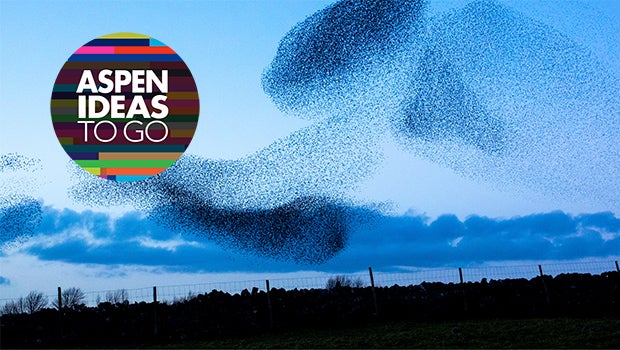The beginning of the year is a good time to reflect and refocus. At the Aspen Institute, we’re remembering advice from our experts and speakers on how to live more mindfully and with purpose. Check out some of their insights below.
Removing a Mindless Mentality
Through the Institute’s Murdock Mind, Body, Spirit Series, which brings a wide range of experts and innovators to Aspen to discuss their latest revelations about the link between mindfulness, physical activity, and emotional well-being, social psychologist Ellen Langer shared her expertise on the psychology behind being mindful.
“Mindlessness is not the same thing as stupidity. You’re on automatic pilot. You’re trapped in a single perspective. You’re insensitive to context. You have rules and routines that are guiding you — governing what you’re doing — that may not make sense any longer,” she said. But how does one combat this state of mind?
“The simplest thing is to adopt an understanding of the inherent uncertainty in everything,” she said. “When we travel, we expect to see new things, but every day in fact there are new things happening all around us.”
Turning Your Life into a “Blue Zone”
Dan Buettner, who also visited the Institute through the Murdock Series, studies parts of the world where people lead longer, healthier, and happier lives. He has dubbed these areas “blue zones.”
“We’ve identified, from observing the longest-lived populations in the world, ways for individuals, families, organizations, and even communities to take some of these good years back,” Buettner said.
After visiting five regions with a team of researchers, Buettner came up with the “power nine” secrets to living a longer, better life. The first is to move naturally. “People did not belong to gyms and they did not run marathons,” Buettner said. “They moved on average every 20 minutes. They had gardens, they lived in de-convenienced zones, they walked and biked, they didn’t have a button for electronics, they used their hands.”
The blue zone populations know how to “downshift” and reduce stress by practicing yoga, meditation, saying prayers, or eating with their families. They have a sense of purpose and can articulate it. They also eat wisely, drink a little bit of alcohol (usually wine), eat a plant-based diet (with a large amount of legumes), avoid overeating, and regulate portion sizes.
Those who live longer are well-connected in their social networks, put family first, and have monogamous spousal relationships. And, most have faith, regardless of a specific religion. Buettner referred to a study that shows people who show up to a faith-based community at least four times a month and are active live four to 14 years longer than those who do not.
A Tibetan Monk on How to Cultivate Inner Peace
Being at peace with oneself can also have a ripple effect to the surrounding world, says Sakyong Mipham Rinpoche, a Tibetan high priest and head of the Shambhala lineage. One of the best ways to combat the current state of the world, Rinpoche explained, is through changing the way that we look at ourselves.
“A lot of the external aggression we see, and the instability, is really a reflection of how we regard ourselves as people — as selfish and faulted,” he said.
But how can we change this view of self? Meditation, correctly done, can trigger the changes necessary to shift one’s view of oneself — and then to project that positive view onto others as well. Though many people view meditation as a retreat from the world, Rinpoche said it should be the opposite: a way to deeply connect with inner thoughts and feelings.
“Meditation should ultimately enable you to relax with who you are,” he said. “You have to work with your own imperfections and hold them. We have to be able to look at ourselves as basically good — that we are worthy to be, and we have innate dignity as a person. We need to allow ourselves to feel and connect.”
Once you are comfortable with yourself, you will be able to project that onto others. This shift at the individual level can translate into a more harmonious society. If we have a sense and appreciation of our own selves and kindness, we open the pathways to communicate with others — because we care about how we feel, and thus how others feel.
“We can shift at a daily level by empowering the communication, thoughts, and feelings in our minds,” he said. “It may not be dramatic, but all of a sudden it begins to have a very subliminal effect.”
Goldie Hawn Puts Her MindUP to the Task
Goldie Hawn may be best known for her acting, but she also created the Hawn Foundation to promote brain health and improve social-emotional awareness in children. Its signature program is MindUP, which aims to cultivate positive social and emotional characteristics, like empathy, in students.
Early on in the program, leaders found that with mindfulness training, children can better manage their emotions, their executive functions are quicker, they cooperate better in the classroom, and they are less likely to be bullied. While other social-emotional programs are well-intentioned, Hawn said, they tend to deal with problems such as bullying reactively or with a band-aid approach — telling kids not to bully instead of dealing with the underlying social-emotional situation.
MindUP techniques, in contrast, include gratitude circles, journals, and acts of kindness. The foundation of the program is rooted in neuroscience, and teaching kids how their brains work. What’s been most impactful for Hawn, she said, is hearing young children explain to their parents and other adults how their emotions relate to their prefrontal cortexes, amygdala, or other parts of the brain.
“This could mitigate mental health issues,” added Hawn. “For a better world for our children, what each and every one of us can devote some time and effort to, is to become mindful, to become a symbol for our children. That’s the job we have to do in this very troubled world.”

